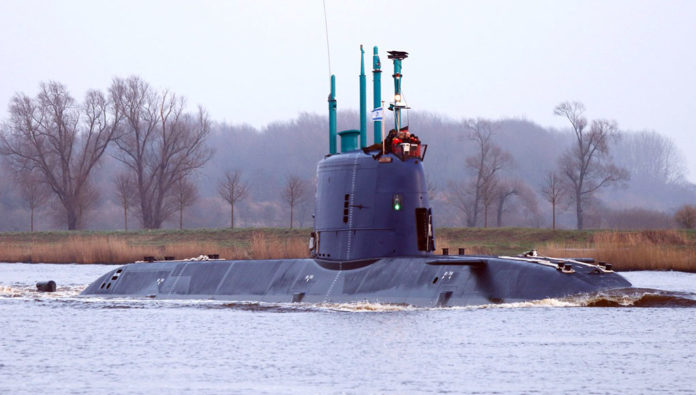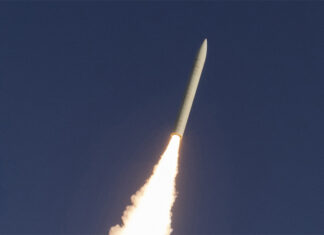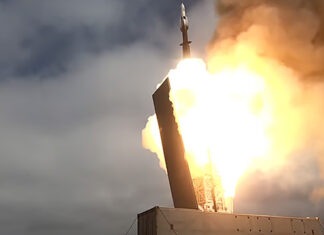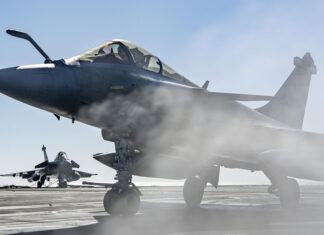Stretched along the eastern Mediterranean Sea and linked to the Indian Ocean through the Gulf of Eilat and the Red-Sea, Israel has always strived to maintain a naval force to protect its maritime border and sea lines of communications. Since the 1970s, following repeated terror attacks from the sea, the Israeli Navy assumed the responsibility to combat terror at sea and along the coast. Since the late 2000s, after major discoveries of natural gas reserves offshore, the Navy also added a new role – the security of the country’s Economic Exclusion Zone (EEZ) and protection of offshore marine infrastructures.
Since the induction of the Dolphin class submarines in the 2000s, the Israeli Navy also assumed a strategic Deterrent role. According to unconfirmed foreign reports, Israel’s Dolphin class submarines are equipped with oversized tubes capable of launching nuclear-tipped cruise missiles that can provide the country a retaliatory second strike capability, in case Israel is attacked and its first line of strategic assets – ballistic missiles and attack aircraft – are destroyed by surprise, nuclear attack.
These added responsibilities come with a growing piece of Israel’s defense pie, a larger share of the acquisition budget and more attention at the highest levels in the Ministry of Defense and Prime Minister office. In recent years, senior naval officers were selected for prominent positions in the MOD R&D department (DR&DD), Defense Export Agency (SIBAT), Intelligence agencies (Mossad), the National Security Council (Malal) and major government operated defense companies, to name only a few.
Unlike the air and land forces, that rely heavily on US Foreign Military Sales (FMS), the Navy maintained independent procurement sources in Israel and Europe. Since the 1960s Israel’s Navy surface ships were all constructed in Israel by the Israel Shipyards and IAI. The exception were two Shimrit class hydrofoils built in the USA in the 1980s (and scrapped a few years later), and three Saar V corvettes, constructed in the 1990s in the USA and are in service today.
As for the submarine force, since the late 1960s Israel maintains a fleet of three submarines (which allows the Navy to keep at least two operational subs at any time). The loss of INS Dakar in 1968 left the Navy with only two subs for eight years, until the first Type 209 Gal class submarine 1976 was launched. Type 209 were the first subs designed and built specifically for the Israeli requirements by the German submarine designer Howaldtswerke-Deutsche Werft (HDW), although these boats were built in the UK.
The Israel Navy maintained close relations with HDW in the following years, with the design and construction of a larger class subs – the Dolphin. These submarines were built in Kiel in Germany and provided a significant boost strengthening the German shipyard.
The acquisition cycles of Israeli submarines accelerated over time. From 20 years between the Gal and Dolphin generation, the period reduced to 12-16 years between Dolphin I and Dolphin II (AIP). The reduced cycle means the Israel Navy can now operate several submarines simultaneously, while the other are undergoing heavy maintenance. The recent decision to buy three additional, yet unnamed submarines in the next ten years sets the next cycle at only 10-13 years, from the current buy, maintaining Israel’s capability to operate four submarines simultaneously through the 2030s.
What is the rush? Why does Israel require such increased capability?
The simple answer: increased operational tempo that evolved with the growing operations of naval forces in the area; however, this argument is weak. The ongoing peace with Egypt, the Syrian Civil War and crippled state of Libya all mean reduced threat to Israel’s security, at least from the symmetric, naval side.
However, the Iranian threat is growing. The reasonable need to maintain long-range deterrence patrols added new missions to Israel’s submarine force. According to foreign sources, Israel’s submarines carry cruise missiles that can attack targets at ranges beyond 1,000 miles. While such missiles could hit targets in western Iran, when launched from the Eastern Mediterranean, the Israeli subs could hold the entire territory of Iran at risk, from positions in the Indian Ocean or inside the Persian Gulf.
Israel would likely keep these patrols secret and avoid sailing in the Suez Canal, thus sending its subs on voyages that would take weeks, through the Atlantic and Indian Oceans. Once one operational submarine is committed to such extended patrols, the Navy would likely require two boats for missions in the Mediterranean.
Such arguments would likely be part of the rhetoric used by Israel’s leadership, arguing for the increase of the nation’s submarine force to six, even nine boats. However, this recommendation faced stiff opposition from the Ministry of Defense, due to the high acquisition and operational cost (€500 – 650 million per boat) competing with other priorities. The resignation of Defense Minister Ya’alon from office paved the way for the submarine deal to continue.
But there is another side of the coin – the German side. As explained above, the Israeli Navy has been a loyal and regular client of the HDW shipyard in Kiel, which is now part of the ThyssenKrupp Marine Systems (TKMS) industrial conglomerate. These close relations are likely to continue – despite the revelations that Iranian and UAE corporations have minority holding in it. Notwithstanding these ties, Israel and Germany have signed a contract worth €430 million to build four Saar VI Magen stealth corvettes, based on the German Blohm & Voss designed Classe 130. Soon to be launched third Dolphin II class submarine – Dakar is also a major undertaking soon expected in Kiel.
But the workload at the shipyards has diminished dramatically in recent years. As Type 212 deliveries to the German and Italian Navies completed and construction of Type 214 designs moved overseas, the shipyard will be under pressure to lay off part of its workforce. These hands are critical to maintaining the skills and know-how for the two Type 218SG submarines on contract for the Singapore Navy (the first slated for delivery in three years). Earlier in 2016 TKMS management still hoped to win an A$36 Billion mega-deal in Australia, but after losing this opportunity, the submarine shipyards are striving for a sustainable business for the remaining of the next decade. The prospects for the near term are slim – a future submarine support program in Peru and shortlisting as one of two bidders in Norway. Hence, reaffirming Israel’s commitment to buy three submarines in the future would be a life saver for the crippled shipyard, even if it means a long term prospect.
The decision to proceed with a memorandum of agreement between the Governments of Israel and Germany at this stage is understandable and serves the interests of both sides. But the attempts on both sides to cover the deal are wrong.
Prime Minister Netanyahu claim that the decision is a matter of national security is true but, setting all strategic arguments aside, these moves should be managed by Government officials and diplomats, not by sales agents or private counselors. Furthermore, the investigation of the former deputy of Israel’s National Security Council, who was an active supporter of the submarine deal, adds an unpleasant odor of corruption to the top of Israel’s national security pyramid.




















